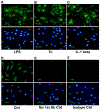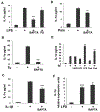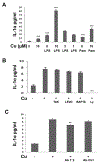Expression and regulation of alarmin cytokine IL-1α in human retinal pigment epithelial cells
- PMID: 29551335
- PMCID: PMC6076434
- DOI: 10.1016/j.exer.2018.03.015
Expression and regulation of alarmin cytokine IL-1α in human retinal pigment epithelial cells
Abstract
Human retinal pigment epithelial (hRPE) cells play important immune-regulatory roles in a variety of retinal pathologic processes, including the production of inflammatory cytokines that are essential mediators of the innate immune response within the ocular microenvironment. The pro-inflammatory "alarmin" cytokine IL-1α has been implicated in both infectious and non-infectious retinal diseases, but its regulation in the retina is poorly understood. The purpose of this study was to elucidate the expression and regulation of IL-1α within hRPE cells. To do this, IL-1α mRNA and protein in hRPE cells was assessed by RT-PCR, qPCR, ELISA, Western blot, and immunofluorescence following treatment with a variety of stimuli and inhibitors. ER stress, LPS, IL-1β, and TLR2 activation all significantly increased intracellular IL-1α protein. Increasing intracellular calcium synergized both LPS- and Pam3CSK4-induced IL-1α protein production. Accordingly, blocking calcium signaling and calpain activity strongly suppressed IL-1α protein expression. Significant but more moderate inhibition occurred following blockage of TLR4, caspase-4, or caspase-1. Neutralizing antibodies to IL-1β and TLR2 partially eliminated LPS- and TLR2 ligand Pam3CSK4-stimulated IL-1α protein production. IFN-β induced caspase-4 expression and activation, and also potentiated LPS-induced IL-1α expression, but IFN-β alone had no effect on IL-1α protein production. Interestingly, all inhibitors targeting the PI3K/Akt pathway, with the exception of Ly294002, strongly increased IL-1α protein expression. This study improves understanding of the complex mechanisms regulating IL-1α protein expression in hRPE cells by demonstrating that TLR4 and TLR2 stimulation and exposure to IL-1β, ER stress and intracellular calcium all induce hRPE cells to produce intracellular IL-1α, which is negatively regulated by the PI3K/Akt pathway. Additionally, the non-canonical inflammasome pathway was shown to be involved in LPS-induced hRPE IL-1α expression through caspase-4 signaling.
Keywords: Caspase-4; IL-1α; Interleukin-1α; Non-canonical inflammasome; RPE; Retinal pigment epithelium; TLR2; TLR4.
Copyright © 2018 Elsevier Ltd. All rights reserved.
Figures








Similar articles
-
Distinct CD40L receptors mediate inflammasome activation and secretion of IL-1β and MCP-1 in cultured human retinal pigment epithelial cells.Exp Eye Res. 2018 May;170:29-39. doi: 10.1016/j.exer.2018.02.014. Epub 2018 Feb 16. Exp Eye Res. 2018. PMID: 29454857 Free PMC article.
-
TLR4 mediates human retinal pigment epithelial endotoxin binding and cytokine expression.Invest Ophthalmol Vis Sci. 2005 Dec;46(12):4627-33. doi: 10.1167/iovs.05-0658. Invest Ophthalmol Vis Sci. 2005. PMID: 16303959
-
TLR4 mediates human retinal pigment epithelial endotoxin binding and cytokine expression.Trans Am Ophthalmol Soc. 2005;103:126-35; discussion 135-7. Trans Am Ophthalmol Soc. 2005. PMID: 17057796 Free PMC article.
-
Regulation of interleukin 1α secretion by inflammasomes.Ann Rheum Dis. 2013 Apr;72 Suppl 2:ii96-9. doi: 10.1136/annrheumdis-2012-202252. Epub 2012 Dec 19. Ann Rheum Dis. 2013. PMID: 23253918 Review.
-
Function and regulation of IL-1α in inflammatory diseases and cancer.Immunol Rev. 2018 Jan;281(1):124-137. doi: 10.1111/imr.12615. Immunol Rev. 2018. PMID: 29247991 Free PMC article. Review.
Cited by
-
Evidence for the involvement of interleukin-1α during development of experimental cytomegalovirus retinitis in immunosuppressed mice.Cytokine. 2021 Aug;144:155596. doi: 10.1016/j.cyto.2021.155596. Epub 2021 May 30. Cytokine. 2021. PMID: 34078571 Free PMC article.
-
TLR4-mediated pyroptosis in human hepatoma-derived HuH-7 cells induced by a branched-chain polyunsaturated fatty acid, geranylgeranoic acid.Biosci Rep. 2020 Apr 30;40(4):BSR20194118. doi: 10.1042/BSR20194118. Biosci Rep. 2020. PMID: 32270855 Free PMC article.
-
Anti-inflammatory potential of simvastatin and amfenac in ARPE-19 cells; insights in preventing re-detachment and proliferative vitreoretinopathy after rhegmatogenous retinal detachment surgery.Int Ophthalmol. 2024 Mar 26;44(1):158. doi: 10.1007/s10792-024-03067-z. Int Ophthalmol. 2024. PMID: 38530532 Free PMC article.
-
IL-1 Family Members Mediate Cell Death, Inflammation and Angiogenesis in Retinal Degenerative Diseases.Front Immunol. 2019 Jul 16;10:1618. doi: 10.3389/fimmu.2019.01618. eCollection 2019. Front Immunol. 2019. PMID: 31379825 Free PMC article. Review.
References
-
- Aksoy E, Taboubi S, Torres D, Delbauve S, Hachani A, Whitehead MA, Pearce WP, Berenjeno IM, Nock G, Filloux A, Beyaert R, Flamand V, Vanhaesebroeck B, 2012. The p110delta isoform of the kinase PI(3)K controls the subcellular compartmentalization of TLR4 signaling and protects from endotoxic shock. Nat Immunol 13, 1045–1054. - PMC - PubMed
-
- Bandyopadhaya A, Bhowmick S, Chaudhuri K, 2009. Activation of proinflammatory response in human intestinal epithelial cells following Vibrio cholerae infection through PI3K/Akt pathway. Can J Microbiol 55, 1310–1318. - PubMed
-
- Bian ZM, Elner SG, Yoshida A, Elner VM, 2003. Human RPE-monocyte co-culture induces chemokine gene expression through activation of MAPK and NIK cascade. Experimental eye research 76, 573–583. - PubMed
Publication types
MeSH terms
Substances
Grants and funding
LinkOut - more resources
Full Text Sources
Other Literature Sources

